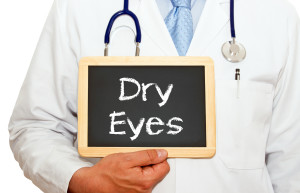 With the heat of summer in our rear view window, the cool of winter is rapidly approaching. With the cooler weather comes increased problems for people with dry eyes.
With the heat of summer in our rear view window, the cool of winter is rapidly approaching. With the cooler weather comes increased problems for people with dry eyes.
Dry eyes can be caused by a variety of factors. The two main causes to dry eyes are when the body doesn’t create enough tears, or the tear film is not consistent and the tears evaporate too quickly. In the United States, 14-33% of the population has dry eye. Five million people over the age 50 are effected by dry eyes. Millions more are effected with less severe symptoms, which can change over time due to many different factors.
According to the National Eye Institute, dry eye can be caused by a temporary or chronic condition:
- Dry eye can be a side effect of some medications, including antihistamines, nasal decongestants, tranquilizers, certain blood pressure medicines, Parkinson’s medications, birth control pills and anti-depressants.
- Skin disease on or around the eyelids can result in dry eye.
- Diseases of the glands in the eyelids, such as meibomian gland dysfunction, can cause dry eye.
- Dry eye can occur in women who are pregnant.
- Women who are on hormone replacement therapy may experience dry eye symptoms. Women taking only estrogen are 70 percent more likely to experience dry eye, whereas those taking estrogen and progesterone have a 30 percent increased risk of developing dry eye.
- Dry eye can also develop after the refractive surgery known as LASIK. These symptoms generally last three to six months, but may last longer in some cases.
- Dry eye can result from chemical and thermal burns that scar the membrane lining the eyelids and covering the eye.
- Allergies can be associated with dry eye.
- Infrequent blinking, associated with staring at computer or video screens, may also lead to dry eye symptoms.
- Both excessive and insufficient dosages of vitamins can contribute to dry eye.
- Homeopathic remedies may have an adverse impact on a dry eye condition.
- Loss of sensation in the cornea from long-term contact lens wear can lead to dry eye.
- Dry eye can be associated with immune system disorders such as Sjögren’s syndrome, lupus, and rheumatoid arthritis. Sjögren’s leads to inflammation and dryness of the mouth, eyes, and other mucous membranes. It can also affect other organs, including the kidneys, lungs and blood vessels.
- Dry eye can be a symptom of chronic inflammation of the conjunctiva, the membrane lining the eyelid and covering the front part of the eye, or the lacrimal gland. Chronic conjunctivitis can be caused by certain eye diseases, infection, exposure to irritants such as chemical fumes and tobacco smoke, or drafts from air conditioning or heating.
- If the surface area of the eye is increased, as in thyroid disease when the eye protrudes forward or after cosmetic surgery if the eyelids are opened too widely, dry eye can result.
- Dry eye may occur from exposure keratitis, in which the eyelids do not close completely during sleep.
Treatment to dry eye varies tremendously, often led by the cause of the disease. Is it an inflammatory reaction? Hormonal? Temporary or constant condition? Is it due to a inflammatory or mechanical defect of the lids? These are just a few of the questions the doctors here at Metrolina Eye Associates ask, observe, and try to learn in determining the most effective way to treat each patient.
Also, Metrolina Eye uses the latest technologies to determine the type of dry eye each patient may present. In each of our clinical rooms, we have a device called a TearLab. This device allows us to measure the osmolarity of the tears in each eye. Osmolarity is an important biomarker in determing ocular surface health. This will help guide our treatment of dry eye disease. Also, we incorporate the use of InflammaDry. This device tests for a marker found in people with dry eye signifying an inflammatory response to dry eye. These devices help us determine the type of dry eye we are dealing with, guiding our decision on treatment.
The professionals at Metrolina Eye are well versed and experienced in finding the right treatment for the specific type of dry eye every patient that comes into our practice may present with. Be sure to ask about treatment options to any of our doctors when you come in for an appointment. You can get started right here by contacting us. We look forward to serving and helping you enjoy more comfortable vision.



